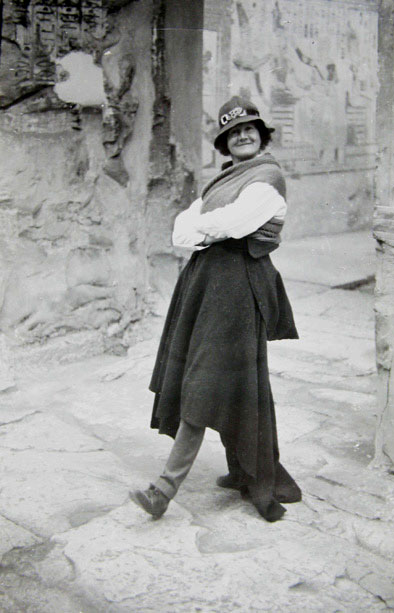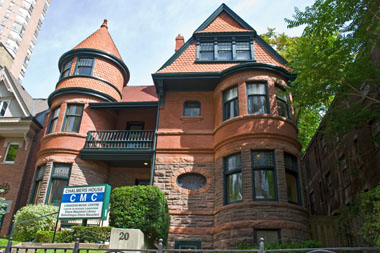Amice Mary Calverley, Egyptologist, documentarian, humanitarian, composer (born 9 April 1896 in Chelsea, London, United Kingdom; died 10 April 1959 in Oakville, Ontario). Amice Calverley is best known in the field of Egyptology, as an author and illustrator of four volumes documenting the decorations in the temple of King Seti I in Abydos, Egypt. She was also a composer of chamber music, songs and an opera. During the First and Second World Wars, she was involved in the Allied war effort as a nurse and civilian relief worker, respectively.

Ancestry, Childhood and Education
Amice Calverley was the second of four children of Edmund Leveson Calverley, an army major and librarian, and Sybil Maitland Calverley, née Salvin. Amice’s maternal grandfather, Osbert Salvin, was a renowned ornithologist and entomologist as well as a pianist, and her mother and aunt were skilled artists. According to her niece Sybil Rampen, Amice had inherited her father’s photographic mind and was trained as an artist by her mother.
Amice and her two brothers, Hugh and Osbert, were born in the wealthy London borough of Kensington and Chelsea. In 1903, the family moved to Bloemfontein, South Africa, where her father worked as an archivist and librarian for the new British colony in South Africa. Amice’s youngest sister, Caroline, was born there in 1904. In 1909, Edmund Calverley’s post was abolished, and the family returned to England. Amice was admitted to Bedford High School for Girls that same year. While still in her teens, she also studied art at the Slade School of Fine Art, the art school of London’s University College. She also took piano lessons with James Friskin, a young Scottish-born pianist and composer who later joined the faculty of the Institute of Musical Art in New York (now the Juilliard School of Music).
Immigration to Canada and Early Work
In 1912, the Calverleys immigrated to Canada and settled in Oakville, Ontario. What prompted the move is unknown, but Edmund Leveson Calverley soon left the family and returned to England, where he remarried. Amice Calverley continued her music studies at the Toronto Conservatory of Music (now the Royal Conservatory of Music) with Healey Willan.
When the First World War broke out in 1914, Calverley’s life and music studies were disrupted. She worked in a munitions factory and began training as a nurse at the Hospital for Sick Children in Toronto but didn’t complete the training. Instead, she worked as a masseuse at the Christie Street Veterans’ Hospital in Toronto, then known as the Toronto Military Orthopedic Hospital. At the same time, she achieved some local success with her music: in 1916, her musical children’s play The Magic Fishbone was performed at the Toronto Conservatory, with proceeds aiding the armed forces at the front.
Calverley was also a skilled seamstress. Around 1920, she traveled to New York City for a career in fashion. She worked as a mannequin and dress designer and found employment with Wanamaker’s department store.
Composer
In 1922, Amice Calverley returned to England on a scholarship from the Royal College of Music (RCM) in London. She studied composition with Ralph Vaughan Williams, one of the most renowned British composers of the time, and George Dyson, later the director of the RCM. By March 1926, she had completed an opera, titled Vel. It was pitched to the Vienna Opera House but was not accepted; to this day, it has not been published.
While most of Calverley’s compositions date from the 1910s and 1920s, she did not give up music after embarking on a career as an Egyptologist (see below). She had a clavichord made so she could play during her field trips and continue to compose. Her String Quartet in F minor, written in 1933, saw performances in Vienna, London and Toronto. However, she could not make a name for herself as a composer; in a 1935 review of a Toronto concert featuring some of her music, she was only referred to as a “former student of the Conservatory,” while the other featured composers were named.
In recent years, Calverley’s music has been rediscovered and performed more regularly within the Greater Toronto Area. In 2015, she was named an Associate Composer of the Canadian Music Centre (CMC). Her manuscripts were entrusted to the CMC by her niece, artist and author Sybil Rampen, and are being digitized and recorded.
Egyptologist
In 1926, Amice Calverley realized she could not support herself as a composer and turned to her artistic talent for an income. She found a job with the University of Oxford’s Ashmolean Museum, illustrating a book by archaeologist V. Gordon Childe. Leonard Woolley, another prominent archaeologist working with the Ashmolean, encouraged her to develop her drafting skills.
This endeavour connected her with the Egypt Exploration Society. In 1925, the Society had started a photographic survey of the Temple of King Seti I in Abydos, Egypt — one of the best-preserved pharaonic temples, dating from around 1300 BC. Calverley joined the project in 1927 as a draftsperson. However, the available photographic material turned out to be unsatisfactory, so under the direction of eminent Egyptologist Alan H. Gardiner, Calverley was sent to Abydos to produce new photos as well as manual drawings of the temple’s extensive artwork. She began her first field assignment in January 1928 and her second in the winter of 1928–29.
During the second stay, Calverley met John D. Rockefeller, who visited the site with James H. Breasted from the Oriental Institute of the University of Chicago. Impressed with Calverley’s work, Rockefeller assured funding for an elaborate publication featuring her illustrations, as well as for further fieldwork.

The Temple of King Sethos I at Abydos
With long-term funding secured, Amice Calverley was able to hire an assistant in 1929: Myrtle F. Broome, herself a highly skilled artist. The two women met in Marseille, France, en route to Abydos in October 1929 and quickly became friends. Together, they spent the subsequent eight winters in Abydos (1929 to 1936–37), meticulously documenting much of the artwork in the temple. Their work was published in three volumes titled The Temple of King Sethos I at Abydos (1933, 1935 and 1938) and highly praised by the Egyptologist community. According to Egyptologist Alan H. Gardiner, the illustrations contained many linguistic errors made by the ancient scribes, but almost no copying errors by Calverley or Broome.
The Second World War interrupted the fieldwork and delayed subsequent publications. Calverley returned to Abydos with a new team in the 1947–48 season; after that, diplomatic difficulties prevented further work at the site. Volume IV of The Temple of King Sethos at Abydos was not published until 1958. By that time, Calverley lived in Oakville, Ontario, and was working on volumes V and VI until her death in 1959. These two last volumes have remained unpublished.
Humanitarian and Documentarian
When living in Abydos during the 1930s, Amice Calverley used her training as a nurse to offer medical help to the locals. She and Myrtle Broome distributed ointments, bandages and other remedies. Later, during a 1947 cholera outbreak in Abydos, Calverley obtained and administered vaccines to local villagers as well as British and Americans in Upper Egypt at the time.
During the Second World War, Calverley was on various assignments for aid organizations and the British government. She helped evacuate children from English cities, worked briefly with the Embassy in Egypt to help discourage an Arab rapprochement with Nazi Germany, and analyzed photos for the Royal Air Force. Towards the end of the war, in 1944, she enrolled as a civilian relief worker for the United Nations Relief and Rehabilitation Administration (UNRRA) in the Balkans.
In the 1930s, Calverley had also begun documenting local customs on film — both in Egypt and in countries where she traveled between field seasons, such as Romania and other Balkan states. When the Second World War was over and her work in Abydos had been discontinued, she traveled to Crete to work on a similar documentary. However, as the Greek government was fighting a civil war against Communist insurgents, Calverley turned towards filming the war and helping to care for the wounded. She became an advocate for veteran care and used her film to raise funds and awareness.
With her health declining, Calverley eventually had to abandon her travels. She settled in Oakville, Ontario, around 1950.
Personal and Social Life
Amice Calverley never married or had children, although she was engaged three times and received many more proposals. She was a polyglot and engaged open-mindedly with any community she became part of. During her extended stays in Abydos, she had friendly relations with the locals and socialized with high-ranking officials and royals who visited the temple. Always curious and eager to acquire new skills, she not only studied Arabic, but also took drumming and flying lessons.
In her later life in Oakville, she became known in the Toronto arts community for the chamber music concerts she hosted. Her dedication to Toronto’s cultural life also showed in her donations to the Royal Ontario Museum. These included a 200-piece collection of 18th-century china from England, as well as 800 pieces of Romanian embroidery she had saved from destruction in the Second World War.
Death and Legacy
Amice Calverley died on 10 April 1959 from an aneurism while preparing a concert. Her death was reported widely across North America. Obituaries appeared in the New York Times and the Evening Star in Washington, D.C.
To preserve Calverley’s legacy, her niece, Sybil Rampen, created an archive and cultural centre in Oakville located on the estate purchased in 1950 by Calverley’s brother Hugh (Rampen’s father). Calverley’s writings, recordings and personal correspondence are stored there. This includes over 700 pages of musical manuscripts, slides, many original paintings and drawings as well as a collection of artifacts from Calverley’s fieldwork in Abydos (beads, amulets, coins and other antique objects). The latter has been studied and catalogued by the Society for the Study of Egyptian Antiquities since 2006, but many items of interest to Egyptologists and musicians await further study.
Calverley has been lauded as a remarkable pioneer and artist. Her valuable contribution to Egyptology is widely acknowledged within the field. The rest of her legacy, particularly in music — which she named as her real passion — has yet to be fully recognized.

 Share on Facebook
Share on Facebook Share on X
Share on X Share by Email
Share by Email Share on Google Classroom
Share on Google Classroom





